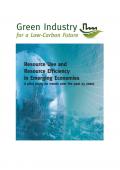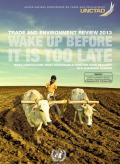
This report examines patterns and trends in resource use and resource efficiency in 16 selected emerging economies between 1985 and 2005. In order to facilitate comparison, the authors divided these countries into three different groups according to their dominant strategy of economic development since 1985: resource-based economies with a high ratio of raw materials in exports, including Algeria, Argentina, Brazil, Chile, Morocco, Russia and South Africa; industry-based economies which have been expanding their capacity to produce manufactured goods and related services, including China, Costa Rica, Malaysia, Mexico and the Republic of Korea; and services-based economies that have largely based their development since 1985 on services (e.g. tourism, financial or knowledge-based industries), including Barbados, Egypt, India and the Seychelles. While none of these three development paths is exclusive, they are useful categories for analytical purposes, as each is linked to specific physical or material profiles in terms of resource use and resource productivity.
In less than a decade, clean energy transitioned from novelty products to the mainstream of world energy markets. The sector emerged not so much in a linear fashion as episodic – in fits and starts associated with the worldwide economic downturn, continent-wide debt crises, national policy uncertainty, and intense industry competition. Through it all, however, the clean energy sector moved inexorably forward, with overall investment in 2012 five times greater than it was in 2004.
Although 2012 investment levels worldwide declined 11 per cent, to US$ 269 billion, the clean energy sector weathered the withdrawal of priority incentives and initiatives offered by governments in numerous key markets, demonstrating its resilience. Reliable clean energy investment data have been collected for nine years now. Looking at the data in three-year increments, average clean energy investment increased by at least US$ 90 billion triennially – from an average of US$ 64 billion in the 2004-06 period to an average of US$ 156 billion in 2007-09 and US$ 245 billion in 2010-12.

This report aims at providing the emerging lessons from a representative sample of case studies in 20 developing countries that could help policy makers to address implementation challenges, including overcoming political economy and affordability constraints. The sample has selected on the basis of a number of criteria, including the country's level of development (and consumption), developing country region, energy security and the fuel it subsidies (petroleum fuel, electricity, natural gas).

This publication explores the commonalities between the existing and proposed paradigms and approaches to development that ensures well-being and respect for nature, and the concept of green economy in the context of sustainable development and poverty eradication. More specifically, the study examines the opinions expressed by Argentina, Bolivia, Cuba, Ecuador, Nicaragua and Venezuela, with regard to the adoption of a green economy as a pathway towards sustainable development.
